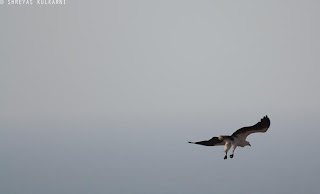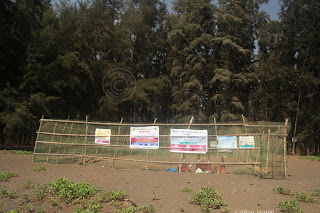Continued from - CKRT: Day 02 - Shrivardhan to Anjarle
Route: Anjarle -> Harne -> Suvarnadurga -> Anjarle -> Dapoli -> Burondi -> Ladghar -> Kolthare -> Dabhol -> Dhopave -> Anjanvel -> Guhagar
After getting up early in the morning, we quickly set out towards Harne. Quite a few locations were on the mind - the Light-house, the fish market, the citadel of Harne and most importantly the Suvarnadurga fort.
After we left Anjarle, sun had risen, and standing on the hill which overlooks Anjarle beach, the scene around can be described by only one apt word - नजारा! Starting from the Kadyavaracha Ganapati (कड्यावरचा गणपती) on the right, to the dense coconut backyards, to the clean Anjarle beach, to the sea to the creek that separates Anjarle from Harne, to the small Konkani houses doting the coast, to the Suvarnadurga fort ... and all of this goldenified by the rising sun. It was a beautiful sight. One which makes you forget whys and whats and wheres.
Exact opposite was the route that we took to Harne. It was a short coastal route, but very dirty and it was stinking bad. We still found couple of moments to try and capture Suvarnadurga apart from a large group of egrets feasting on dead fish (again!).
Harne
The citadel of Harne was in ruins. Crossed.
 |
| Citadel of Harne |
|
|
While I was sitting there taking in the views, suddenly I noticed something big flying towards me. It was much bigger than a kite. While I kept staring at it in awe, it came at perched right in front of me - around 20-30 feet. Such a grandios pose and mannerisms. It was an eagle, goddamnit. It looked like a juvenile of a Greater Spotted Eagle! Lifer!
Life is never fare. And you know that in black-and-white clarity, if you are into photography. I had a magnifiscent eagle sitting merely 20-30 feet in front of me, bathing in sunlight, with sun behind me, on a perch which was dramatically separated from the background ... in short all things favourable ... and my camera had a wide-angle lens on it! And to add to the misery, my monstrous tripod was hanging by my shoulder.
| |||
|
I tried to make most of what I could get of that eagle, and them came back down towards the jetty. By that time, a large crowd had assembled on the Harne beach. Turned out, that was the fish-market we were after.
The Fish-Market of Harne
After having enough of the market, we got back on the road to get our breakfast. It was 8:45am and we didn't have much time to feed ourselves.
By the time we retured back to the jetty, another group of 3 guys from Pune itself, had had arrived and was looking for ferry to Suvarnadurga. In next 5-10mins, we had boarded a motorboat together, and were on our way to the fort.
Suvarnadurga (सुवर्णदुर्ग)
The beach on which the motorboat docked after traveling for about 15-20mins, was a fantastic small white-sand beach. It was a swimming paradise, since the beach was gaining depth very quickly. Unfortunately, however intense the urge was, we neither had time, nor spare clothes to go swimming right then and there. Something has got to give sometimes.
There are some water cisterns, some store rooms, a small secret passage-way and a still standing massive and impressive fortification. That's about it. Nothing much.
Dabhol
We checked out after returning to Anjarle, and left towards Dabhol via Dapoli->Burondi->Kolthare. Had lunch mid-way in Dapoli. The road from Anjarle to Dapoli is excellent. That from Dapoli onwards towards Dabhol is not that good though. A new road is being laid out and it might get much much better in next few months.
En route Dabhol, we saw some of the finest typical Konkani villages, which one would immediately fall in love with. There was one called Panchnadi was which settled along a descending hill before the jetty, and the style of those houses, their scarcity, the shallow flowing river with crystal-clear water - enough for its bottom to glitter with falling sun-rays, and the dense jungle around made it a serene and surreal place which I would only dread of in my dreams.
When we got to Dabhol jetty, a ferry boat had already docked and my bike got accomodated immediately. We were lucky once again.
Gopalgad of Anjanvel अंजनवेलचा गोपाळगड
After alighting at Dhopave, we started towards Anjanvel to visit Gopalgad. We passed the Enron of Dabhol on our way, and it seemed like it was in working condition - contrary to what we believed. To add to our surprise, after we took the turn for Anjanvel, we noticed Enron's gigantic cooling towers were humming, with water streams dripping. So it was indeed producing electricity.
 |
| The Enron of Dabhol |
For getting into Anjanvel, one has to climb down the steep, very steep wall on one side of the town, and controlling the speed on those steep slopes calls for circus. Had those sloped been any steeper, we would have to reach Anjanvel head-first on gravitational assistance.
You get down into Anjanvel and then you realize that Gopalgad is situated on the steep mountain wall on the other side of the town. If getting down was hard, going up is even harder, with the front wheel barely staying grounded. Any small hint of throttle, and it lifts off. With a pillion and around 30-40kg of luggage on the bike, sensing the front-wheel lifting off of the ground, and much scarier than it sounds.
Gopalgad was a surprise. We were greeted with a board saying - that historical place was actually "a private property and is open for tourists"! That was a first. So far we were under impression that anything, that had anything which seemed even remotely like fortification, is a government property, which the government is entitled to sit over and watch getting slowly destroyed over time. Here a private party was one step ahead, and had already converted the interiors of the fort, into a mango farm! Later I came to know that there was a court-case going on between the Govt of India and the "owner" of Gopalgad, who, as I was told, wouldn't allow hoisting Indian flag on the fort on even national days like 15-Aug and 26-Jan. What a crazy-ass banana-republic we are living in!
 |
| White Bellied Sea Eagle circling over a kill |
We sat there on the fence, clicking this and that, and eventually having a chat with the watchman of the mango farm. The guy was surprisingly knowedgible for his post of a watchman. We talked about various things ranging from the mango produce, profit and loss, to Enron to Jaitapur to local issues there. He told us how supporting Enron would have been beneficial for the villagers, about how the politicians and the "angrez" finally got their way while it was the villagers who lost the offered good life, about where the massive gas pipeline comes from and where it goes, and about how Enron was a gas company rather than an energy company. This last one about Enron being a gas company, jolted me to the core. This kind of an observation needs a keen mind and a shrewd analytically thinking mindset. Definitely not something expected of a mango-farm-watchman in some sleepy village. What we had in him was a shrewed, very well learned guy with balanced and fair opinions which even educated people hardly have these days. His opinions didn't suit his humble job.
The Light-house
We moved on towards the light house. This was the first time I was seeing one. It being a govt. property, and we being hardened terrorists, on our mission to recce and blow-up a small-time harmless light house, we were not allowed to carry our cameras inside. The place was impeccably well maintained, despite being 50-60 years old. The prisms and lighting system was mounted on a revolving setup and we were told it starts automatically at predefined times, and I could notice it was connected to some external network, possibly for remote command and control operations.
It was absolutely windy on top of the lighthouse. Had we not have any support, we would have got blown away smoothly into Guhagar. That's how maniacally wind was blowing up there.
Guhagar
After getting down, we left towards Guhagar. Again the climb, after leaving Anjanvel towards Enron, was marauding. Somehow managed it, and in about half an hour, we reached Guhagar.
I had already called and arranged for the stay, while wandering on Gopalgad. The Jog family turned out to be very sweet, homely, talkative and welcoming one. We kept discussing this and that, eventually landing on different connections in Sangli, while gorging on a fantastic set of थालीपीठ, before we set out to the place where we were going to stay.
The Guest House ... or was it a Ghost House!?
It was a huge Konkani house, it turned out, that we had rented at mere Rs.200/- per head. A 200 year old at that! And there were only two of us - me and Pravya - who were going to stay in that huge and lonely house, that night. And boy did the place have a feel! All the doors and their hinges were squeaking. A portable wooden ladder was leading to a dark attic, which we dared not look at. There was a full-size wooden swing in the porch, which was half-broken on one side yet in movable condition, and it would make a very apt sound while moving - custom-made for announcing arrival of ghosts in a starry new-moon night.
And then to complete the treatment, when we are placing our luggage in thr biiig hall, suddenly out of nowhere, came an army of big black ants (मुंगळे), which reminded me of The Mummy, and made me wonder if a cockroach-eating muscular guy would enter the room next, from that mysteriously dark attic and wring our necks like hapless chickens. But before anything of that could become a reality, we left the place under the pretext of checking out the new Durga-devi temple in the city. That goddess specialized in handling such cockroach-eating-muscular-maniac kinds afterall.
It turned out to be a very beautiful temple; and as part of the महापूजा, प्रसाद-वाटप was under way, by the time we reached there. There was शिरा in the प्रसाद and no-one says no to शिरा. We made them ask more than once, and we didn't say no on either occassion. It was a damn well made one.
That day when we returned and made our beds, we were half-expecting some payals and/or a satanic-laughter jolting us anytime out of our sleep in the middle of the night. It was a freaking 200 years old house after all.
Owing to the exertion of the day, though, I fell asleep even before my mind could render and race behind the legs wearing those payals or the face behind that satanic-laughter.
Next: CKRT Day 04 - Guhagar to Ganapatipule


































































